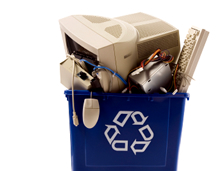As technology becomes ever more prevalent in our society so does the amount of electronic waste. Each year a number of new gadgets or devices are produced leaving the outdated models to be discarded. The production of new devices is not a bad thing especially since advancements in technology keep us moving forward and increases our productivity. However the same can not be said for how we handle the disposal of our old electronics. The short life span of electronic devices causes us to continuously dispose of more and more electronic waste each year.
Due to the amount of e-waste most states have already put in place standards against dumping electronic devices. Similarly in 2010 the Federal Government enacted the Electronics Recycling Act. This Act states that any organization that is found to be exporting their non-useful e-waste to developing countries will receive heavy penalties and fines. Many companies have recently begun to focus their efforts on establishing guidelines to reduce their amount of e-waste and ensure their compliance with green standards. Although these types of companies are providing the groundwork for a successful reduction in electronic waste it is really up to the individual consumers to follow through with this proposal by disposing of their old devices appropriately.
There are four main ways that we currently handle our electronic waste which is through landfills, recycling, reusing, and incineration. While certain methods may be more suitable than others each of them can still produce negative impacts on our health and environment. Approximately 14-20 million PC’s are discarded making up a huge portion of the 20-50 million tons of electronic waste that we produce annually. From that 20-50 million tons only around 14% of the old products are actually recycled which leaves the rest of the millions of electronics to accumulate and be disposed in a counterproductive manner.
Landfills:
The major problem associated with e-waste is the composition of toxic heavy metals (lead, mercury and cadmium, etc.) that can seep into our water, soil, or atmosphere depending on how it is disposed of. Toxic heavy metal from e-waste makes up 70% of all heavy metals in landfills. Using a landfill for e-waste is very dangerous because it contaminates essential aspect of our environment.
Incineration:
Like in landfills the incineration option releases massive amounts of hazardous waste into the atmosphere. Although incineration will reduce the amount of space used for e-waste the release of this hazardous material into the environment would not only affect the atmosphere but would eventually make its way into our water supply and soil when it rains.
Recycling and Reusing: (Most Viable)
It is extremely expensive to appropriately handle electronic waste. Due to the high cost of disposal many corporations were exporting their old products to developing countries and therefore resulted in several law and guidelines. Developing countries often have lower environmental policies and are not adequately equipped to handle the disposal of e-waste. The Responsible Electronics Recycling Act of 2010 was enacted to prevent the hazardous material from being exported to countries that are unable to properly deal with it. As for the equipment that is still working properly and meets the necessary guidelines it can still be recycled which can help the developing countries even though the majority of working exported devices are obsolete. In the past, hazardous electronic waste in developing countries had been linked to causing cancer, neurological and respiratory disorders, as well as birth defects hence the stronger environmental enforcement regulations.
In addition, these disturbing statistics have also urged companies to create “Take Back” or recycling policies. Take back policies and recycling programs let you trade in your working electronic devices, sometimes for cash, store credit, discounts, new models, or the satisfaction of helping your environment. Once traded in the company can either choose to use the device for parts (Recycle) or export it (Reuse).
What you can do to help:
Although the government is attempting to solve the problem of e-waste it is up to the customers of electronic devices to dispose of them properly and follow the regulations that the government sets forth. The following are some suggestions when dealing with and disposing of electronic waste.
- Avoid throwing out electronics with your everyday garbage.
- If you are getting an upgrade or newer model, donate or sell your old device.
- Consider if you really need an upgrade or if you can utilize the same device.
- Shop with companies that use a “Take Back” program.
- Make it a priority to shop with companies with “Green Principals”
- Try to purchase sustainable/upgradeable devices.
- Don’t buy the latest technology right away because there will most likely be something better only a month or two away. Why upgrade twice and create twice the waste?
- Contact your local representative regarding your state’s electronic waste policy. Does your state have an e-waste policy?
- Locate local e-waste recycling and disposal centers.
- Find useful information on Recycling procedures, Takeback programs, and Donation centers at the Environmental Protection Agency Waste Center Resource.
Additional information available at: Examples of Electronic Take Back Programs & Companies with the best Green Rank
Thanks for Reading and Have a Great Earth Day!
Dustin
Providing Tech Support for Businesses in Maryland








